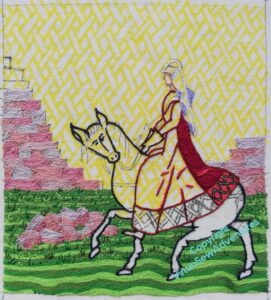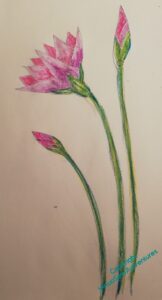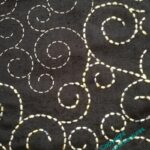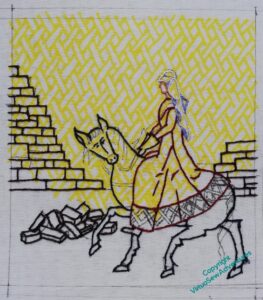Tag: Designing
I’ve not forgotten Aethelflaed…
… although I will admit that sometimes I don’t manage to fight away all the things that get between me and my frame at a time of day when I have any chance of stitching her sensibly!
However – I’ve done the grass!
Well, I stopped doing tussocks when I thought I might want to do more extensive tussocks in the foreground, and decided to do the horse first, in case I wanted seedheads nodding over its legs. But apart from the tussocks, the grass is done.
However, that means I now have a decision to make…



I’ve decided she’ll be mounted on a grey (contrasting with William The Marshall’s chestnut), and that it will be grey tending to blue. But which blue, and how much blue, and what colour should the lightest shade be? This is going to be important, as I think I’m not going to do dapples this time, just shading and a smooth coat.
Some thinking required…
Tackling Stones And Tussocks
You may recall that when I was stitching William Marshall, I chose to use more strands of silk in the needle, and to stitch relatively calm curves and unevennesses in the ground. I wanted to suggest that William’s kinsman kept the land around the walls of his stronghold close clipped (by grazing, one presumes) so as to ensure that he could not be take too much by surprise, whether by welcome or unwelcome visitors.
Aethelflaed, of course, is visiting, in effect, a building site. She has no road, and her horse is picking its way around heaps of building stone and over grass that’s tussocky and and uneven. I gave some thought to the question of how to represent that, staying true to the aesthetic, using only silk and split stitch, but creating some of my own variations. After all, this is modern, inspired by the past, not a reconstruction of an existing piece. I have a little freedom of movement here!

So I’m using three different greens, and I’ve not increased the thickness of the silk in my needle. I’m not stitching the curves quite as regularly, and I’ve devised a way to stitch little tussocks at uneven intervals across the ground. They are just little groups of split stitch lines crossing the flows of colour, but I think they are working rather well so far.
It has only just occurred to me, however, that I may have a slight tweak to make in my process for doing them, as I come forward: they need to get bigger, cross more of the lines of colour. Do I now just put the colour in, so that small tussocks don’t compete visually with large tussocks, or do I just carry on regardless?
Now, a reminder that I shall be giving a talk for the Embroiderers Guild on June 3!
I believe I’ve turned this image into a link to the Eventbrite page, and for anyone not in the right timezone, or otherwise occupied on the day of the talk, the Guild makes recordings available for some time afterwards.
I shall remind you every week until it happens!
Questions About A Wall
So, having once decided to redo the walls, I had to actually do it!
I’m rediscovering the quiet process I found with William Marshall, sitting down at my frame of a morning, working until the sun comes around and casts shadows across the work, or until I find myself losing focus, whichever comes the sooner. You may recall that I was surprised to find myself so enamoured of a technique that involves only a single stitch!
This time, however, that single stitch is very much part of the conception of the project, and I have learned that I can delight in the subtleties of something that once would have bored or frustrated me. I am pleased to find I’m still enjoying it, and in spite of the unusual level of pre-designing I’ve done (and I’ve yet to really get started on Rahere and Lady Julian!), there are still details and ideas to work out.

I’m keeping to the close tones I chose, using two of the three possible blends, and two solid colours. I think that is working well to represent the assorted colours in Cheshire sandstone, while being pale and pulled back, not dominating Aethelflaed but allowing her to dominate instead.
I have been quietly, methodically, choosing a silk, stitching my square spirals, stitch by stitch and block by block, thinking only to raise the remnants of the Roman Walls so that Aethelflaed can restore them.
And then, last week, I was blamelessly stitching my blocks, when I looked at my design with a new eye, and suddenly I have a thought to think through.
Notionally, for me, Aethelflaed in this design is outside the walls, touring the building site, as it were. That’s one of the reasons that I made the wall more than head-high on the rider. However, last week it suddenly seemed to me that visually, that high wall was blocking Aethelflaed’s view, and I’m not sure I want that.
Fortunately, I have all the rest of the silk embroidery, including the borders (still not entirely designed!) before I need to be certain of my decision.
Not quite starting over…
Well, what with putting her away over Christmas and then taking some time to make a decision about what to do next, it’s been a while since you saw Aethelflaed..
And here I am, snipping and snipping away at all of the wall outlines, the blocks I’d already stitched, and even the pile of blocks ready to be reused.
All gone!
And now, the section behind her and her horse is reinstated, using a mixture of blends and a couple of single colours. The tones are much closer together than they were originally, and I’ve also chosen not to use the dark outlines and dark “mortar”. This will help to create a more subtle background, while still having the pinky-orange of Cheshire sandstone. I’ve seen all these colours in various bits of Chester’s Walls – I’ve just chosen, this time, not to include the much darker browns and plum colours which are also there.
So much of representational art, whether it be painting or embroidery, comes down to a question of editing. What do I want to emphasize? What do I want to play down? How can I balance the colours, the shapes, the patterns, to tell the story I want to tell?
Looking at the newly worked section from further away, I think I’m happy now that the wall will pull back as I need it to.
Now I just need to keep going!
More Thoughts on a Coat..

I want my design for the Lotus Coat to be big and bold, maybe a bit blousy, so what I have here may be a bit formal, and need rethinking.
Well, happy to do that, I had a lovely morning in the studio playing with these ideas, and I think what I have now is a good point for further play.
The idea of this set of designs is that the single lotus in the image to the right here will reach almost the whole way across the top of the back, from one seam setting in the sleeve to the other, while the supporting buds will be set in fact a little lower than they are shown.
Meanwhile, on the front there will be something very similar on the left and right front.
I don’t want to make these identical – that would be too formal. So I want to create something that looks balanced, that doesn’t make me look as though I have one shoulder higher than the other.
I’m also planning how to actually achieve all this. At the moment, I’m thinking that I will try to find a light, loosely woven silk fabric that I can dye to match the tweed and stitch on that. Then I can do the stitching and be making the Coat at the same time. I’m not much of a dressmaker, so it might take a while. So I’ve ordered some samples from Whaley’s of Bradford, to try stitching on.
And for the stitchery? At the moment, I think, lots of line stitches in varying shades of white, lilac, and pink, using relatively heavy threads (at least in comparison with Aethelflaed’s filament silk!). Opportunities to use my favourite chain and feather stitch variations, to layer up stitch and effect – I might even find some angora or similar for some slightly fluffy areas. Not so densely stitched, perhaps, that you can’t see the silk, and through it, the tweed.
Of course, by the time I get to doing the stitching, I may have an entirely different idea…
Lotus Flower Coat – starting to plan..
When we visited last year, my aunt gave me a lovely length of faience blue tweed, and although I could, of course, make a skirt (another skirt!), the idea eventually came to me to make it into a sort of cross between a cardigan and a jacket – something that I can wear with lots of things, that makes a good additional layer in our cold house, but looks cheerful and casually smart.
I thought about the colour, and some variant on the Egyptian Lotus Flower pattern seemed like a good start. Then I thought some more, and decided that the very graphic, formalised versions used in border patterns would want to be used formally and make the garment too formal. The tweed is relatively unfulled, and widely sett, so anything too structured won’t work well.
Something like this, I think. It’s a Simplicity pattern from the Seventies or early Eighties, and it won’t be hard to lengthen. It will be lined (which the pattern doesn’t call for), but there are few pattern pieces and almost no shaping.
Naturally, it won’t be going to go undecorated…!
Maybe a border pattern?
Somehow, no. I’ve not done one before – the Coat of Many Flowers has a swathe across the middle, and the Jacket of Many Stitches has the pattern dripping down from the shoulders – but I think it might end up looking a bit obvious, and a bit formal. I’ll still think a bit more about this one, but I’m pretty sure it won’t be this.
Watch this space, as they say…
Rebooted!
Having a Twixmas project has become part of my year for more than one reason. Firstly because usually I have to hide away my main project, as the table I work beside takes the Christmas tree. But secondly, and in some ways more importantly, it helps me “reboot” myself. Last year in particular, I ran out of “me” before I ran out of year, by quite a few weeks, and sitting quietly doing something I didn’t have to do any planning for turned out to be a proper reboot.
Because I’ve come up with ideas for making progress with Placidus, who’s been losing forward momentum for quite a while, as well as having ideas for another embroidered coat..
Placidus first. We’ve been remembering the description of the fresco in “The Herb of Grace”, and it’s slightly mad, the characters of Placidus, his horse and dogs, and the stag all a bit big and out of scale with the forest, and with little vignettes of animals in the spaces in the canopy.
Placidus had stalled because I’d got caught up in having the design planned out before I started. It’s going to be a big design, and for all my drawing and design skills have improved enormously over the years, a very taxin one. So, the reboot is to do what I did, in fact, with Amarna – start doing fragments that will be part of it, and worry about assembly when I get there.
Shortly after having that thought, I found myself watching a documentary in which Hamza Yassin was on the track of Britsh birds of prey, and remembered a bit of blue gauze I have in my stash.
Well, now.
So I started with pausing the documentary and taking a few photos of one of the hawks. Then I found the gauze and drew a very light outline in one corner of it. I’m going to be freestyling this one – part of continuing the reboot and reminding myself of my True Love in stitching.
Having Doubts…
You may recall that I became concerned about the wall and the colours beside Aethelflaed’s riding dress. I filled in some stones, and had even more doubts.
Cheshire sandstone is an absolute horror to depict in stitch or paint – every time I’ve tried in the past I’ve missed in one direction or another. So I’m not especially concerned that this version is proving exasperating too. I just need to find a way to create something I can live with. And indeed, something that Aethelflaed can live with!
The sensible thing seemed to be to do the back panel of the dress and then look seriously at the combination. So here we are, back panel of the dress, including the bright, dramatic, interlaced pattern on the border.
I do need to retweak the highlight on the skirt, somehow, but I have dress and the border in place, and I think the wall colours are definitely going need a bit of tweaking.
So with the idea in mind of blending colours to make the walls sit back from Aethelflaed a little more quietly, I did some experimentation.
Now I have to make some decisions, of course!
Aethelflaed Begins to Progress..
The first stage is to outline everything, so here goes…
Since a white veil would have been an important part of the outfit, I’ve made sure the shadows are outlined in blue. That will make the white seem whiter, making the day seem sunnier.
I’ve given her mittens, rather than gloves – that may be cowardice (no fingers to do!) – but it will make for simpler shapes. How much the Medieval Movers and Shakers will wander from a truly medieval style and sensibility, I don’t know as yet, but I’m trying to keep my wanderings within reason.
Anyway, here we are, all principle outlining completed.
It barely shows, but the stones are outlined using three different shades of dark brown. It shows a little more in real life, and it might helpd to create slightly different impressions on patches of stonework. We’ll have to wait and see about that!
I’ve left the horse’s headstall and harness unstitched – I’m going to stitch that over the top of the main horse stitching.
I’ve not really tackled the grass, even in thought. I’m intending to make it tussocky – another contrast with William Marshall, approaching his kinsman’s well-kept castle, with undergrowth kept back from the walls. But how – I’ve no idea as yet!
I have another problem, anyway. I’ve started to put the walls in, and I’m more than a little concerned that the contrast of the stonework, if I continue like this, is going to be much too high, pulling the wall forwards and dominating the picture.
I can’t have that – Aethflaed is the one I want people to see. Her work comes after her.
So now I’m wondering about blending the colours to soften the change. That feels like a rather un-medieval thing to do, somehow, so I have to decide whether that’s a point I’m willing to concede.
Raising A Needle At Last
Having at last settled on a design for Aethelflaed, there was a certain amount of jockeying around to get the size right and everything in order to start stitching.
As you can see, I’ve got William prepared to be mounted, but he’s still unmounted, which makes him easy to compare. The direction of the designs are contrary, there will be more red and brown in Aethelflaed, and I think the white horse will be rather necessary to help lift it.
You will see that I’ve already added the guidelines for the planned basketweave underside couching. I found adding them later really nerve-wracking, so this time I put that in first, and then the important bits of design went over the top, in a different colour and more precise line..
I was able to gather some of the threads from among those I used for William, which has helped. Partly because it’s always good not to have to buy more than you need, but also because it will help the series “talk” to one another if the palette of colours has some continuity. And then some of the others were passed on to me by Sue from TortoiseLoft (thank you, Sue!).
It has occurred to me (very recently) that if I keep the same blue background in the border, that will also keep the conversation going among the designs. I’m also considering winding the roses around the barrels and skeps, again to keep the conversation going.
But finally – FINALLY!! – I’ve managed to get started!
I’ve used three different browns in the outlines of the stones of the wall, and a very dark blue-grey for the horse.
There’s much more to do, but my goodness, I’m glad to have begun. I know Aethflaed must have been feisty but her embroidered representation has been living up to every bit of it.
Now, what would she have called her horse?




























